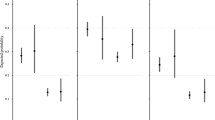Abstract
Objective
To evaluate whether microscopic hematuria (MH) patients with a negative initial evaluation have an elevated risk for urinary carcinoma.
Methods
This is a population-based retrospective study with a matched control identified 8465 adults with an MH ICD code, an initial negative urinary malignancy work-up of cystoscopy and CT urography, and at least 35 months of clinical care. 8465 hematuria naïve controls were age, gender, and smoking status matched. Subsequent coding of non-prostatic urinary cancer, or any following hematuria codes: additional microscopic unspecified or unspecified hematuria, and gross hematuria was obtained. Χ2 tests were performed.
Results
There was no statistically significant difference in urinary malignancy rates (p > 0.05). Any urinary cancer: cases 0.74% (63/8465; 95% CI 0.58–0.95%)/controls 0.83% (71/8465; 95% CI 0.66–1.04%%) (p = 0.54); bladder: 0.45%/0.47% (p = 0.82); renal: 0.31%/0.38% (p = 0.43); ureteral: 0.01%/0.02% (p = 0.56). Subsequent gross hematuria in both males and females increased the odds of cancer: males 2.35 (p = 0.001; CI 1.42–3.91); females 4.25 (p < 0.001; CI 1.94–9.34). Males without additional hematuria had decreased odds ratio: 0.32 (p = 0.001; CI 0.16–0.64). Females without additional hematuria 0.58 (p = 0.19; CI 0.26–1.30) and both genders with additional unspecified hematuria/microscopic hematuria males 1.02 (p = 0.97; CI 0.50–2.08) and females 1.00 (p = 0.99; CI 0.38–2.66) did not have increased odds ratios (p > 0.05).
Conclusion
MH patients with initial negative evaluation have a subsequent urologic malignancy rate of less than 1% and likely do not need further urinary evaluation unless they develop gross hematuria.
Graphical abstract




Similar content being viewed by others
References
Barocas DA, Boorjian SA, Alvarez RD, et al. Microhematuria: AUA/SUFU guideline. J Urol. 2020;204(4):778-786.
Davis R, Jones JS, Barocas DA, et al. Diagnosis, evaluation and follow-up of asymptomatic microhematuria (AMH) in adults: AUA guideline. The Journal of urology. 2012 Dec;188(6S):2473-81.
Madeb R, Golijanin D, Knopf J, et al. Long-term Outcome of Patients With a Negative Work-up for Asymptomatic Microhematuria. J Urol 2010;75(1):20-25.
Pichler R, Heidbegger I, Leonhartsberger N, et al. The Need for Repeated Urological Evaluation in Low-risk Patients with Microscopic Hematuria After Negative Diagnostic Work-Up. Anticancer Res 2013; 33:5525-5530.
Mishriki SF, Nabi G, Cohen NP. Diagnosis of urologic malignancies in patients with asymptomatic dipstick hematuria: prospective study with 13 years’ follow-up. Urology. 2008 Jan 1;71(1):13-6.
Murakami S, Igarashi T, Hara S, Shimazaki J. Strategies for Asymptomatic Microscopic Hematuria: A Prospective Study of 1,034 Patients. J Urol 1990; 144:99-101.
Wakui M, Shiigai T. Urinary tract cancer screening through analysis of urinary red blood cell volume distribution. International Journal of Urology. 2000 Jul;7(7):248-53.
Howard RS, Golin AL. Long-term followup of asymptomatic microhematuria. The Journal of urology. 1991 Feb 1;145(2):335-6.
Davides KC, King LM, and Jacobs D: Management of microscopic hematuria: twenty-year experience with 150 cases in a community hospital. Urology 28: 453–455, 1986.
Edwards TJ, Dickinson AJ, Gosling J,McInerney PD, Natale S, McGrath JS. Patient-specific risk of undetected malignant disease after investigation for haematuria, based on a 4-year follow-up. BJU Int 2011;107:247–52.
Smith MR, Read KC, Stegman ML, Kroll NJ, Van Every MJ. Evaluation of asymptomatic microscopic hematuria by renal ultrasound to detect upper tract malignancy: a 20-year experience in a community hospital. Urology. 2019 Nov 1;133:34-9.
Rothmans K. Epidemiology: An Introduction, Oxford University Press, 2002:132.
Pak JS, Wang EY, Lee K, Pina LA, McKiernan JM, Anderson CB. Diagnostic yield of repeat evaluation for asymptomatic microscopic hematuria after negative initial work-up. Urologic Oncology: Seminars and Original Investigations 2021 May 1;39 (5):300-e1.
Jaffe JS, Ginsberg PC, Gill RA, Harkaway RC. A new diagnostic algorithm for the evaluation of microscopic hematuria. Urology. 2001 May 1;57(5):889-94.
Ghandour R, Freifeld Y, Singla N, Lotan Y. Evaluation of hematuria in a large public health care system. Bladder Cancer. 2019 Jan 1;5(2):119-29.
Edwards TJ, Dickinson AJ, Natalie S, Gosling J, McGrath JS. A Prospective Analysis of the Diagnostic Yield Resulting From the Attendance of 4020 Patients at a Protocol-Driven Hematuria Clinic. BJU Int. 2006;97(2): 301-305.
Yecies T, Bandari J, Fam M,Macleod L, Jacobs B, Davies B. Risk of Radiation from Computerized Tomography Urography in the Evaluation of Asymptomatic Microscopic Hematuria. J. Oncol 2018; 200:967-972.
Khadra MH, Pickard RS, Charlton M, Powell PH, Neal DE. A Prospective Analysis of 1,930 Patients with Hematuria to Evaluate Current Diagnostic Practice. J Urol 2000; 163:524-527.
Acknowledgements
None.
Funding
No funding was involved in this research.
Author information
Authors and Affiliations
Contributions
All authors contributed to the study conception and design. Material preparation, data collection and analysis were performed by CJL, AGR, AM, AG, HS, and JKA The first draft of the manuscript was written by AG and CJL and all authors commented on previous versions of the manuscript. All authors read and approved the final manuscript.
Corresponding author
Ethics declarations
Conflict of interest
No conflict of interest.
Additional information
Publisher's Note
Springer Nature remains neutral with regard to jurisdictional claims in published maps and institutional affiliations.
Rights and permissions
About this article
Cite this article
Lisanti, C.J., Graeber, A., Syed, H. et al. What is the relative risk of urologic malignancy in microscopic hematuria patients after negative evaluation? A long-term population-based retrospective analysis of 8465 patients. Abdom Radiol 48, 1011–1019 (2023). https://doi.org/10.1007/s00261-022-03793-x
Received:
Revised:
Accepted:
Published:
Issue Date:
DOI: https://doi.org/10.1007/s00261-022-03793-x




